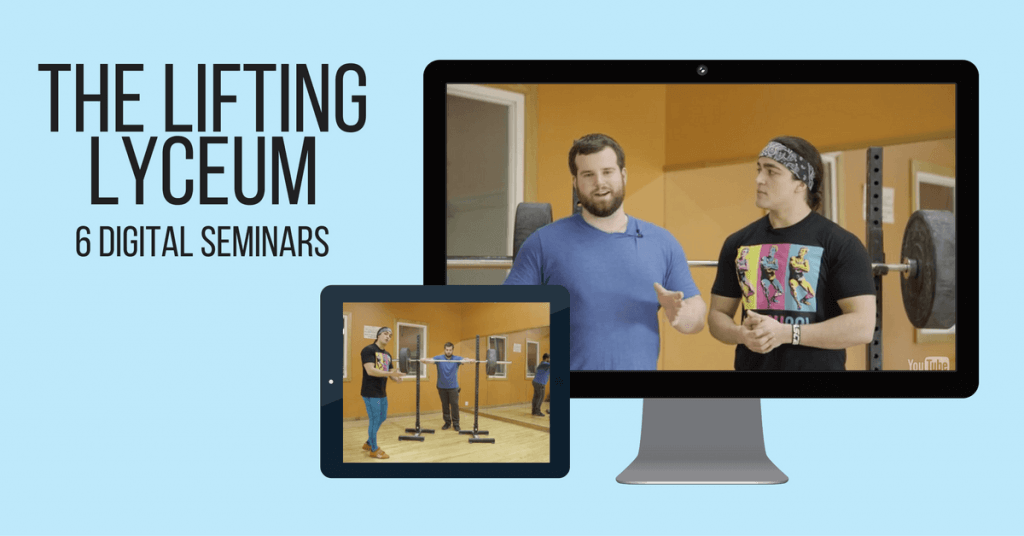Stronger by Science – Full Lifting Lyceum
$119.00 Original price was: $119.00.$39.90Current price is: $39.90.
Years of research and experience condensed in an easily digestible format to help you bust through plateaus and make long-term progress….
Stronger by Science – Full Lifting Lyceum
Lifting can be extremely satisfying, but it can also be supremely frustrating if you’re not getting results fast enough and you don’t know what to do to get the weight moving again.
And where do you find the information you need to break through those plateaus?
5-minute YouTube videos? Short articles with a clickbait headline?
Nope. If anything, that stuff just makes everything more confusing.
Most of the information in the fitness industry only gives you tidbits – information that might be interesting, but that doesn’t really change your training or understanding in any real way.
When I talk to clients, readers, and subscribers, I can see that a lot of people are missing a lot of the “puzzle pieces” required.
If you’re stuck, if you’re at a plateau, or if you’re feeling overwhelmed by all of the conflicting lifting information out there, here’s the harsh reality:
It’s not going to get better if you keep doing the same thing and if you keep reading and watching the same surface-level content.
So what’s the difference between stuck and un-stuck?
It’s simple: You must know how to optimize each lift and your training program for your own body and preferences.
Tweaking your form for a lift to make it optimal for your body can help you add weight to the bar RIGHT NOW. (I’ve seen dozens of clients PR immediately after I’ve given them a few pointers on this topic.)
And learning how to adjust your program based on what your body responds to will insure you ALWAYS have a way to keep making progress and being productive in the gym.
Learning to optimize each lift for your body, and learning to adjust your program based on what you best respond to: These 2 simple things are the difference between stuck and un-stuck, and often the difference between novice lifters and elite liters.
Easier said than done, though, right?
For me, learning the information needed to adjust programs and lifting technique took about 10 years. It took:
- Committing myself to reading exercise science research 2 hours a day, every day for a decade.
- Coaching dozens of athletes.
- Trial-and-error with my own body and programming.
- Talking with some of the best coaches in the world about these topics.
Now, that worked for me since I’ve made lifting and exercise science my full-time job. But you probably don’t have time for that.
Questions we’ll answer:
Seminars 1, 2, and 3 give you practical tools to start adding weight to your lifts immediately.
The first three seminars are on the Big 3, the squat, bench, and deadlift. For each lift, we’ll talk about:
- How to personalize your setup
- Correcting technique flaws
- Accessory movements
- Bringing up weaknesses
- Equipment
- Cues
- Warming up
- Relevant anatomy and biomechanics
We’ll also discuss issues relevant to each lift, such as high bar vs. low bar vs. front squat on the squat, sumo vs. conventional on the deadlift, and different grip widths on the bench.
Seminars 4, 5, and 6 give you the tools for long-term progress: Work Capacity, Training and Programming for Hypertrophy, and Training and Programming for Strength
4. Work Capacity
Training more is usually better, if you can handle it. But what happens when you can no longer recover well enough to keep doing more, or when you simply get so worn out during your workouts that you can’t do more?
We’ll address:
- Determining how much work you can do, and how much work you should be able to do
- How much work you can recover from
- How to increase work capacity
- How to monitor recovery
- How to transition back into training after a work capacity phase
5. Training and Programming for Hypertrophy
- What causes hypertrophy? We’ll talk about tension, damage, and metabolic stress.
- How important is volume for building muscle?
- How do you find the right amount of volume for YOU?
- Is sarcoplasmic hypertrophy real?
- Should you train to failure?
- Is whole body or body part split training better for muscle growth?
6. Training and Programming for Strength
- In-depth discussion of periodization (it doesn’t mean what you think it does)
- What are the correlations between muscle mass and powerlifting success?
- What’s the best way to develop efficiency with the lifts?
- How important is intensity in building strength?
- How often should you lift, and what factors impact that decision?
- How should you peak for a powerlifting meet?
- How much do personal leverages impact strength?
Get Stronger by Science – Full Lifting Lyceum download right now!
Read more: http://archive.fo/vR9n8
Here’s What You’ll Get in Stronger by Science – Full Lifting Lyceum
Stronger by Science – Full Lifting Lyceum : Sample
Be the first to review “Stronger by Science – Full Lifting Lyceum” Cancel reply
Related products
Health & Medical
Kate Freeman – Heart Of Releasing – Masters for Daily Releasing
Health & Medical
Health & Medical
Health & Medical
2018 High Risk Obstetrics Current Trends, Treatments & Issues
Health & Medical
Health & Medical
N. Bradley Keele – Psychopharmacology Update – Medications, the Brain, and Behavior














Reviews
There are no reviews yet.